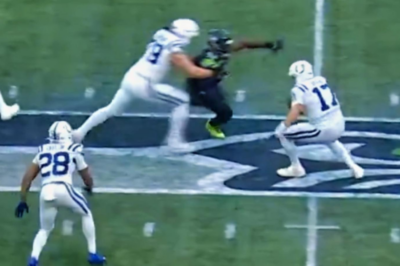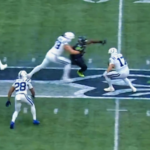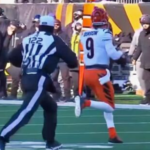A student’s faith was BANNED from her own parking spot. The shocking stand she took will leave you speechless.
In a significant victory for religious expression and student rights, a Colorado high school student has successfully secured permission to repaint her senior parking spot to showcase her Christian faith, overcoming initial opposition from school officials.
In a story that highlights the ongoing debate over religious freedom in American schools, a Colorado high school senior has emerged victorious after a contentious dispute over her right to express her Christian beliefs through her personal parking space.
The student, whose identity has been kept confidential for privacy reasons, faced pushback from school administrators when she attempted to repaint her designated senior parking spot to include religious symbols and messages reflective of her faith.
This case has garnered widespread attention, sparking conversations about the boundaries of free speech, religious expression, and the rights of students within educational institutions.
After a series of discussions, appeals, and public support, the student has been granted permission to proceed with her plans, marking a notable win for religious expression in schools across the nation.
Background: The Student and Her Vision

The student, an accomplished senior at a Colorado high school, has been actively involved in her church community and has openly expressed her Christian beliefs throughout her high school years.
As part of her senior year traditions, she chose to personalize her parking spot, which is a common practice among seniors seeking to leave a lasting mark before graduation.
Initially, she envisioned repainting her parking space with symbols that represent her faith—perhaps a cross, a Bible verse, or other Christian imagery.
Her goal was to use her personal space as a platform to share her beliefs and inspire others who might see her message.
She believed that her parking spot was a form of personal expression protected under her First Amendment rights.
However, her plans met resistance from school officials, who argued that the religious symbols and messages could be considered a violation of school policies on neutrality and non-discrimination.
The school administration expressed concerns that allowing religious imagery might lead to conflicts or create an environment that favors one religion over others, potentially infringing on the rights of students of different faiths or those who are non-religious.
The Initial Conflict: School’s Response and Student’s Rights
The controversy began when the student submitted her plan to repaint her parking spot.
School officials responded with a letter stating that the proposed design could be deemed inappropriate and that it might violate policies against religious proselytizing or the display of religious symbols in certain contexts.
The school emphasized that they wanted to maintain a neutral environment where students of all backgrounds feel comfortable.
The student, feeling that her constitutional rights were being infringed upon, sought legal advice and began advocating for her right to express her faith publicly.
She argued that her planned messages were personal and symbolic, not intended to proselytize or offend anyone.
Her stance was rooted in the belief that her First Amendment rights—freedom of speech and religious expression—should be protected within the school setting, especially since her parking spot was her personal property within the school premises.
The dispute quickly gained attention on social media, with supporters rallying behind the student’s right to religious expression.
Advocates for religious freedom argued that restricting her ability to repaint her parking spot was a violation of her constitutional rights, while opponents contended that public schools must remain neutral regarding religion to serve all students fairly.
Legal and Educational Perspectives
This case touches on complex legal and educational issues. The First Amendment of the U.S.
Constitution guarantees freedom of speech and religious exercise, but these rights are often balanced against the need for public institutions to maintain neutrality and prevent endorsement of particular religious views.
Legal experts note that students do have First Amendment protections in school settings, but these rights are not absolute.

Courts have historically upheld restrictions on religious expression if it disrupts the educational environment or violates school policies aimed at maintaining neutrality.
In this context, the key legal question was whether the student’s right to decorate her parking spot with religious symbols falls within protected free speech or whether it constitutes an endorsement of religion that schools can restrict.
Courts have generally ruled in favor of protecting religious expression when it is personal and non-disruptive, especially in cases involving private property or personal expression.
Educational institutions, meanwhile, grapple with the challenge of respecting individual rights while fostering an inclusive environment.
Many schools adopt policies that prohibit religious symbols in certain contexts to prevent conflicts, but these policies are often challenged when they appear to suppress legitimate religious expression.
The Turning Point: Negotiations and Public Support
After a series of discussions, the school district and the student’s family engaged in negotiations.
The school initially maintained its stance but was open to dialogue, especially after public support for the student grew.
Religious organizations, civil liberties groups, and community members voiced their backing, emphasizing the importance of protecting students’ rights to express their faith.
Legal counsel for the student argued that repainting her parking spot was a form of personal expression protected under the First Amendment, and that the school’s restrictions were unwarranted.
They pointed out that the parking spot was her personal property, and her planned design did not pose a threat or disruption.
In response, the school district agreed to allow the student to repaint her parking spot, provided that the design adhered to certain guidelines ensuring it was respectful and non-disruptive.
The final agreement permitted her to include Christian symbols, Bible verses, and messages of faith, reaffirming her right to express her beliefs publicly within her personal space.
The Significance of the Victory
This case has broader implications beyond the individual student.
It underscores the importance of respecting religious expression in public schools and highlights the ongoing tension between maintaining neutrality and honoring individual rights.
For many advocates, this victory serves as a reminder that religious freedom is a fundamental right that must be protected, even within secular educational environments.
It also emphasizes the need for schools to develop clear policies that balance free expression with inclusivity, ensuring that students can express their beliefs without fear of censorship or discrimination.
Furthermore, the case has sparked a national conversation about the limits of religious expression in schools, with some arguing that students should have the freedom to display their faith openly, while others caution against policies that could favor one religion over others.
Community Reactions and Future Implications
The response from the community has been mixed. Supporters celebrate the student’s victory as a triumph for religious liberty and free speech.
Many see it as a step toward greater acceptance and understanding of diverse religious expressions within public institutions.

Conversely, some critics argue that allowing religious symbols in school spaces could lead to divisiveness or alienate students of different faiths or no faith at all.
They call for clear guidelines to prevent religious expression from becoming a source of conflict.
Looking ahead, this case may set a precedent for other students seeking to express their religious beliefs in school-related contexts.
It could influence future policies regarding personal property, free speech, and religious expression in educational settings across Colorado and beyond.
The Colorado student’s successful effort to repaint her senior parking spot to reflect her Christian faith marks a significant moment in the ongoing dialogue about religious freedom, free speech, and student rights in American public schools.
It underscores the importance of protecting individual expression while maintaining a respectful and inclusive educational environment.
As schools continue to navigate these complex issues, this case serves as a reminder that constitutional rights are fundamental and must be upheld, even in the face of administrative challenges.
It also highlights the power of community support, legal advocacy, and respectful dialogue in defending personal freedoms.
In the end, faith indeed wins—affirming that students’ rights to express their beliefs are vital components of a free and open society.
News
Cameras Capture Patrick Mahomes’ Heartbreaking Reaction After Suffering Serious Knee Injury in Clash with Chargers
Cameras Capture Patrick Mahomes’ Heartbreaking Reaction After Suffering Serious Knee Injury in Clash with Chargers In a highly anticipated AFC…
Philip Rivers Looks Like a 95-Year-Old Grandfather During This Play: A Deep Dive into the Memorable Moment That Had Fans Talking
Philip Rivers Looks Like a 95-Year-Old Grandfather During This Play: A Deep Dive into the Memorable Moment That Had Fans…
SHOCKING VIDEO: Rams Star Puka Nacua Collapses Mid-Play. The Terrifying Moment That Silenced The Stadium.
SHOCKING VIDEO: Rams Star Puka Nacua Collapses Mid-Play. The Terrifying Moment That Silenced The Stadium. In a shocking turn of…
MAHOMES DOWN! His knee buckles in BRUTAL new angle—you won’t believe the video. Chiefs fans, this is terrifying.
MAHOMES DOWN! His knee buckles in BRUTAL new angle—you won’t believe the video. Chiefs fans, this is terrifying. In the…
Joe Burrow’s Teammates Are Officially ‘Done’ With Him: What the Viral Video Reveals About the Cincinnati Bengals QB’s Relationship with His Team
Joe Burrow’s Teammates Are Officially ‘Done’ With Him: What the Viral Video Reveals About the Cincinnati Bengals QB’s Relationship with…
The woman who knew Sherrone Moore best breaks her silence with DISTURBING accusations after 10 years of marriage. You won’t believe what she’s revealing.
The woman who knew Sherrone Moore best breaks her silence with DISTURBING accusations after 10 years of marriage. You won’t…
End of content
No more pages to load












